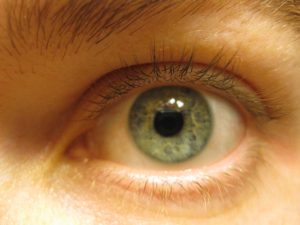One spring day my family and I were sightseeing in Portland where we strolled through an old church. As was my habit, I began telling my visually impaired, color blind daughter, Katy, what I saw: the way the colors splashed through the stained glass, how each window seemed to glow with beauty, how the colors complimented the pictures.
She listened, then pointed upward. “Well, Mom, here’s what I see. There’s a design like a clover that weaves through everything. See? It’s on the pillars and above us, and at the top of each window and then again on each panel of the window. It’s even on every pew. Isn’t it pretty? Maybe it symbolizes the Holy Trinity.”
I was so busy noticing the colors that I totally missed the design. “Wow. Way cool,” I said.
It’s funny. Most of the time I dupe myself into thinking I’m fully sighted. But of course, I’m not. It’s as if I have blind spots all over my soul, places that just can’t see the truth, like the eyeball scotoma (blind spot) where the optic nerve meets the retina.
What I notice often depends on my mood, or my preconceptions of what should be. And my sins obliterate a lot, too. For instance, pride blinds me to my faults. Prejudice blinds me to truth. Hurry blinds me to nature’s beauty. Materialism blinds me to spiritual values.
Apparently Mary Magdalene had similar issues. On the first Easter she was so busy grieving, so sure of Jesus’ death, she didn’t even recognize Jesus when he stood before her. I think this is what Easter helps us do: let God change our perspective so we open our eyes to what has been right in front of us all along.
About fifteen years ago, I received a small book on God’s love. One sentence gravely affected me: “Love opens our eyes: it teaches us to see things beautiful and good which we can never see without it, in nature, in our fellow-men, in God: Love looks for what is lovable and finds it.”
When I first read that quote, I was praying about the resurrection and God’s love. It yanked me from my normal way of seeing life and sucked me into a tornado of soul-changing experience. Just what kind of love could this be, that looks for the lovable and finds it?
Paul’s first letter to the Corinthians, Chapter 13 provided some answers. He wrote that God’s love isn’t the romantic, “you make me feel good,” kind of love. Instead, God’s love acts and lives for the beloved. It is patient and kind. It is ready to excuse, trust, hope, and endure what comes. God’s love doesn’t take offense; it’s not resentful. It delights in the truth, and lasts forever.
I still develop blind spots. They sway their deadly heads like cobras rising from baskets to a swami’s tune and grab my attention for a while. But sometimes, I can truly see!
To learn to love like God, I’ve got to turn my eyes from myself and toward God through daily prayer. I have to focus on the good that comes from my suffering, trusting that God can use it to redeem the situation and me. And sometimes, just sometimes, I can recognize Jesus encouraging and beckoning me to trust that “for those who love God, all things work together for good.”
It’s as if I’m sitting every day with God pointing to things I see – suffering, hardship, turmoil – and I’m saying, “Ak, just look at that!” And then Jesus looks deeply into my eyes and says, “Yes, but did you notice the growth, the love, the tenderness, the help that comes with it, because of it?”
That’s when once again my jaw drops in awe, surprised by love. That’s when I smile at my human frailties, and silly blind spots, and answer, “Wow, Jesus, I hadn’t noticed. Thanks for pointing that out.” That’s when I learn to see.

